FORD F-150 2020 Owners Manual
Manufacturer: FORD, Model Year: 2020, Model line: F-150, Model: FORD F-150 2020Pages: 625, PDF Size: 7.98 MB
Page 311 of 625
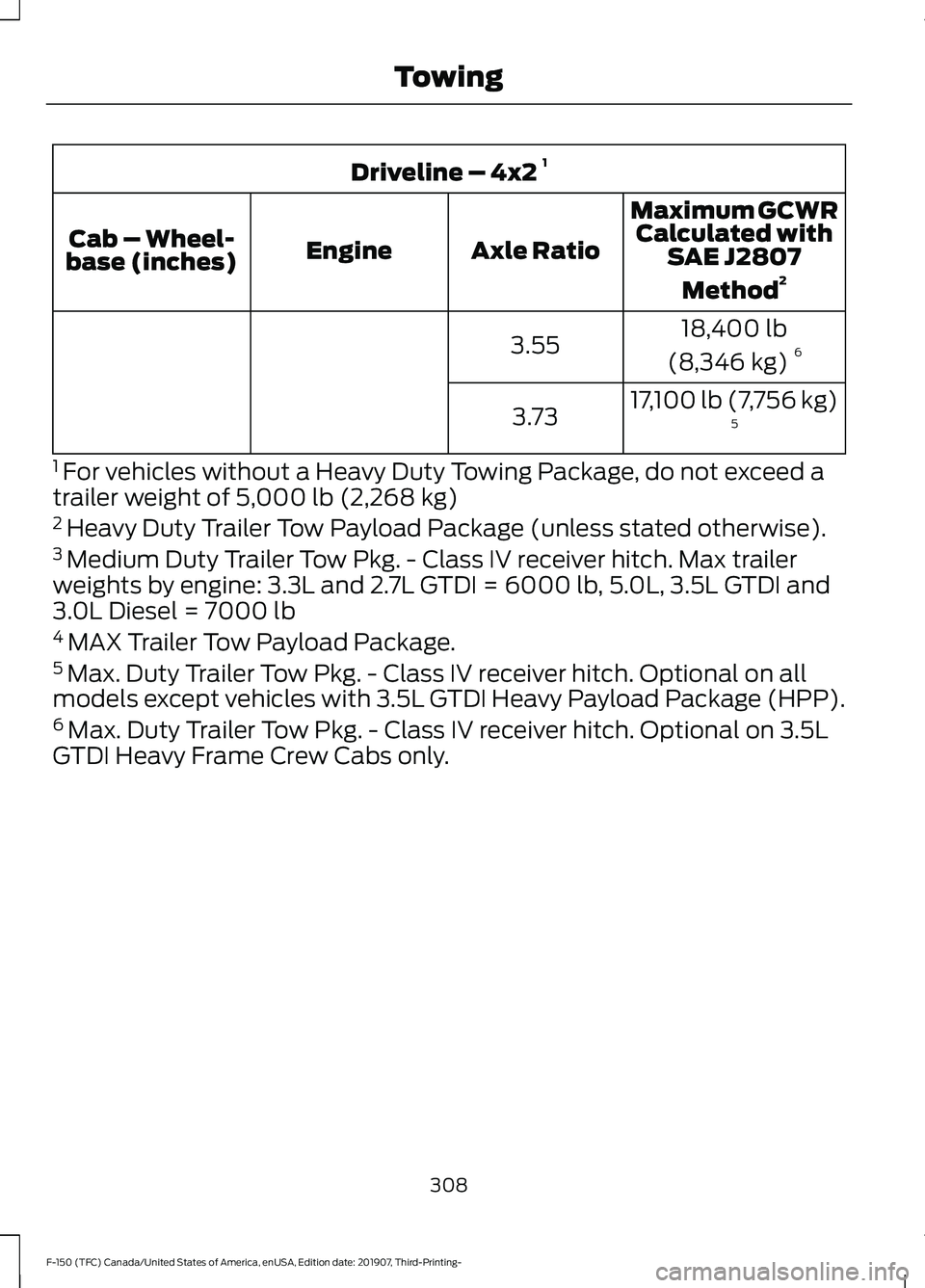
Driveline – 4x2
1
Maximum GCWRCalculated with SAE J2807
Method 2
Axle Ratio
Engine
Cab – Wheel-
base (inches)
18,400 lb
(8,346 kg) 6
3.55
17,100 lb (7,756 kg)5
3.73
1 For vehicles without a Heavy Duty Towing Package, do not exceed a
trailer weight of 5,000 lb (2,268 kg)
2 Heavy Duty Trailer Tow Payload Package (unless stated otherwise).
3 Medium Duty Trailer Tow Pkg. - Class IV receiver hitch. Max trailer
weights by engine: 3.3L and 2.7L GTDI = 6000 lb, 5.0L, 3.5L GTDI and
3.0L Diesel = 7000 lb
4 MAX Trailer Tow Payload Package.
5 Max. Duty Trailer Tow Pkg. - Class IV receiver hitch. Optional on all
models except vehicles with 3.5L GTDI Heavy Payload Package (HPP).
6 Max. Duty Trailer Tow Pkg. - Class IV receiver hitch. Optional on 3.5L
GTDI Heavy Frame Crew Cabs only.
308
F-150 (TFC) Canada/United States of America, enUSA, Edition date: 201907, Third-Printing- Towing
Page 312 of 625
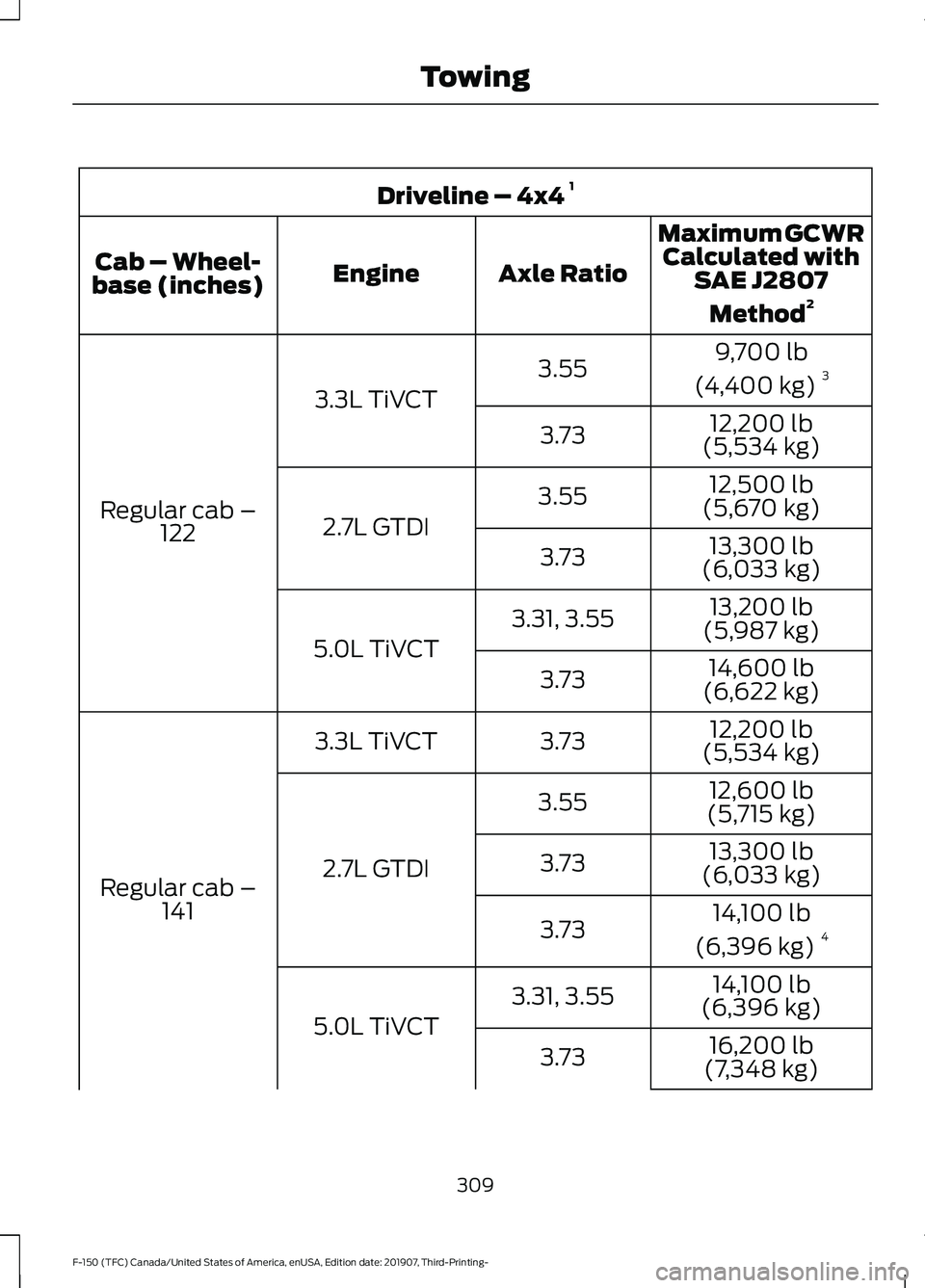
Driveline – 4x4
1
Maximum GCWRCalculated with SAE J2807
Method 2
Axle Ratio
Engine
Cab – Wheel-
base (inches)
9,700 lb
(4,400 kg) 3
3.55
3.3L TiVCT
Regular cab – 122 12,200 lb
(5,534 kg)
3.73
12,500 lb
(5,670 kg)
3.55
2.7L GTDI 13,300 lb
(6,033 kg)
3.73
13,200 lb
(5,987 kg)
3.31, 3.55
5.0L TiVCT 14,600 lb
(6,622 kg)
3.73
12,200 lb
(5,534 kg)
3.73
3.3L TiVCT
Regular cab – 141 12,600 lb
(5,715 kg)
3.55
2.7L GTDI 13,300 lb
(6,033 kg)
3.73
14,100 lb
(6,396 kg) 4
3.73
14,100 lb
(6,396 kg)
3.31, 3.55
5.0L TiVCT 16,200 lb
(7,348 kg)
3.73
309
F-150 (TFC) Canada/United States of America, enUSA, Edition date: 201907, Third-Printing- Towing
Page 313 of 625
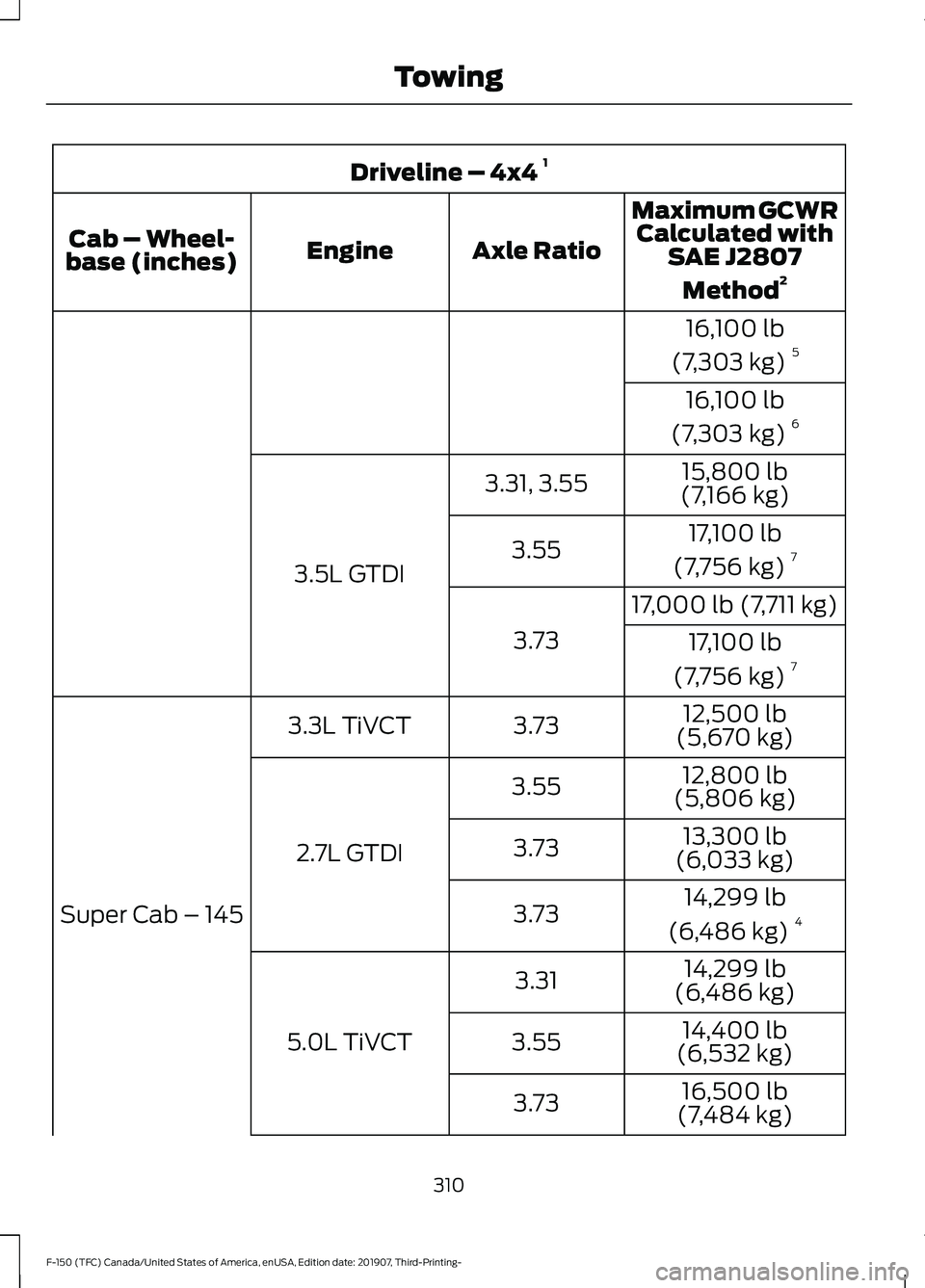
Driveline – 4x4
1
Maximum GCWRCalculated with SAE J2807
Method 2
Axle Ratio
Engine
Cab – Wheel-
base (inches)
16,100 lb
(7,303 kg) 5
16,100 lb
(7,303 kg) 6
15,800 lb
(7,166 kg)
3.31, 3.55
3.5L GTDI 17,100 lb
(7,756 kg) 7
3.55
17,000 lb (7,711 kg)
3.73 17,100 lb
(7,756 kg) 7
12,500 lb
(5,670 kg)
3.73
3.3L TiVCT
Super Cab – 145 12,800 lb
(5,806 kg)
3.55
2.7L GTDI 13,300 lb
(6,033 kg)
3.73
14,299 lb
(6,486 kg) 4
3.73
14,299 lb
(6,486 kg)
3.31
5.0L TiVCT 14,400 lb
(6,532 kg)
3.55
16,500 lb
(7,484 kg)
3.73
310
F-150 (TFC) Canada/United States of America, enUSA, Edition date: 201907, Third-Printing- Towing
Page 314 of 625
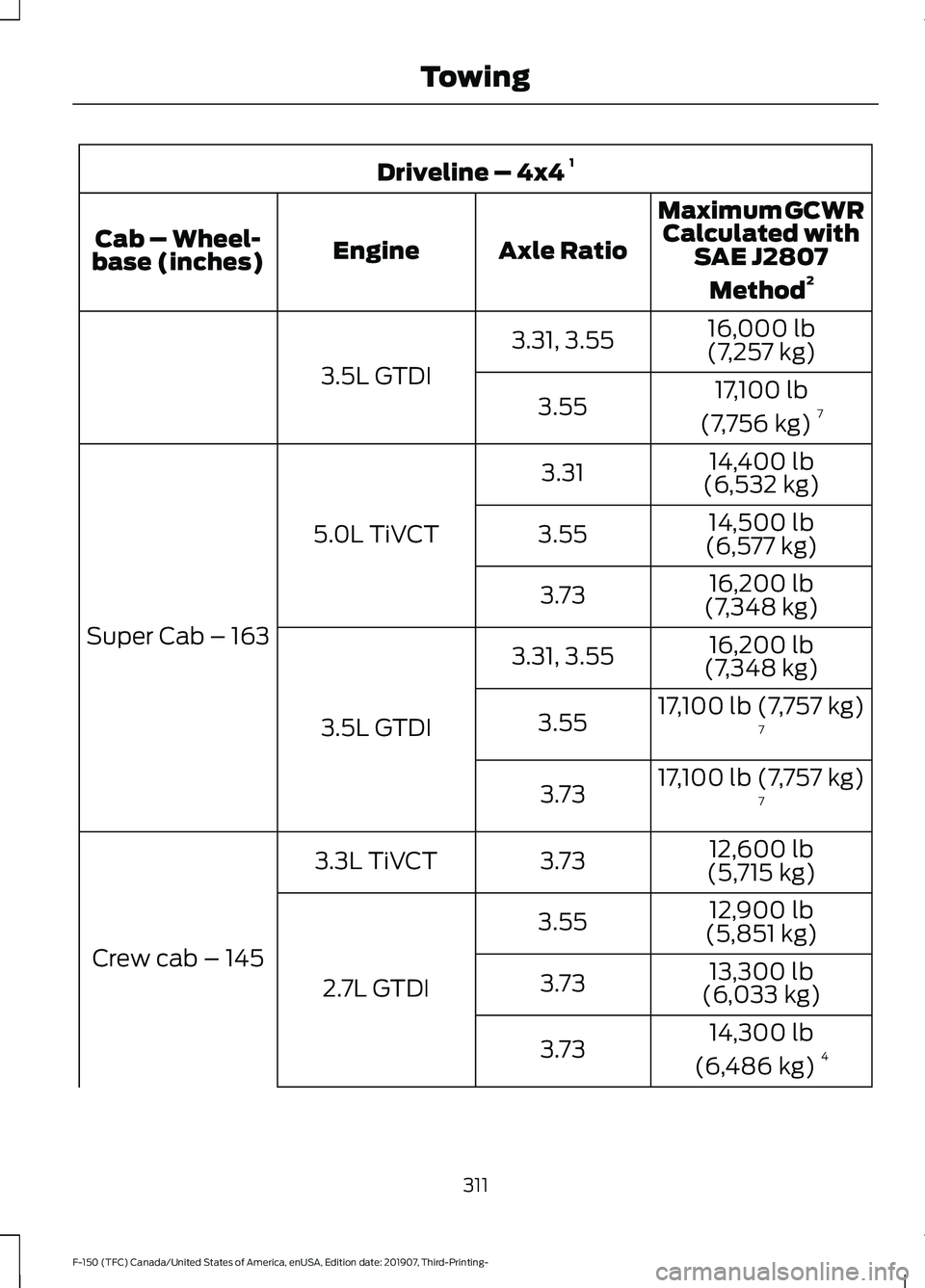
Driveline – 4x4
1
Maximum GCWRCalculated with SAE J2807
Method 2
Axle Ratio
Engine
Cab – Wheel-
base (inches)
16,000 lb
(7,257 kg)
3.31, 3.55
3.5L GTDI 17,100 lb
(7,756 kg) 7
3.55
14,400 lb
(6,532 kg)
3.31
5.0L TiVCT
Super Cab – 163 14,500 lb
(6,577 kg)
3.55
16,200 lb
(7,348 kg)
3.73
16,200 lb
(7,348 kg)
3.31, 3.55
3.5L GTDI 17,100 lb (7,757 kg)
7
3.55
17,100 lb (7,757 kg)7
3.73
12,600 lb
(5,715 kg)
3.73
3.3L TiVCT
Crew cab – 145 12,900 lb
(5,851 kg)
3.55
2.7L GTDI 13,300 lb
(6,033 kg)
3.73
14,300 lb
(6,486 kg) 4
3.73
311
F-150 (TFC) Canada/United States of America, enUSA, Edition date: 201907, Third-Printing- Towing
Page 315 of 625
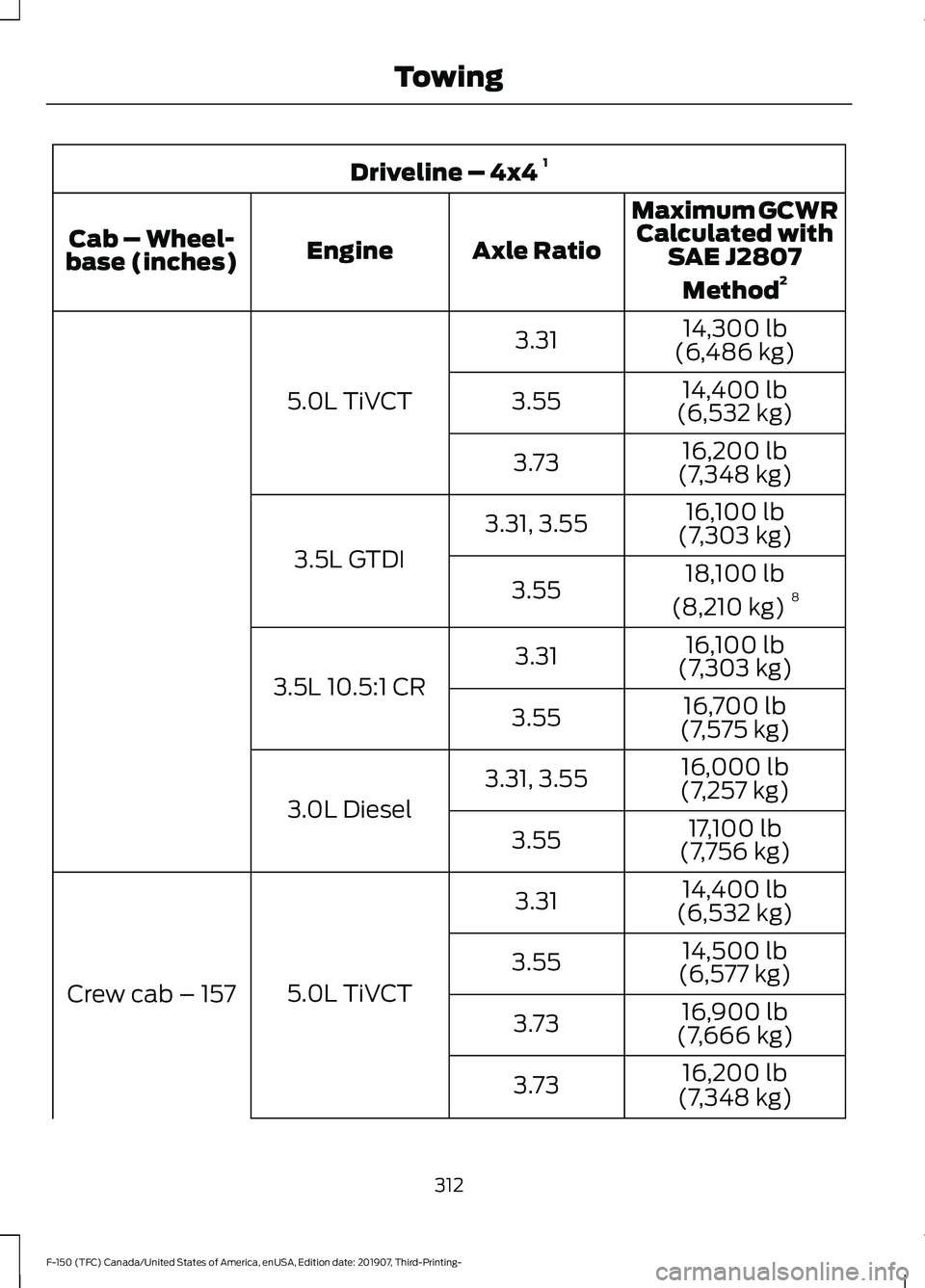
Driveline – 4x4
1
Maximum GCWRCalculated with SAE J2807
Method 2
Axle Ratio
Engine
Cab – Wheel-
base (inches)
14,300 lb
(6,486 kg)
3.31
5.0L TiVCT 14,400 lb
(6,532 kg)
3.55
16,200 lb
(7,348 kg)
3.73
16,100 lb
(7,303 kg)
3.31, 3.55
3.5L GTDI 18,100 lb
(8,210 kg) 8
3.55
16,100 lb
(7,303 kg)
3.31
3.5L 10.5:1 CR 16,700 lb
(7,575 kg)
3.55
16,000 lb
(7,257 kg)
3.31, 3.55
3.0L Diesel 17,100 lb
(7,756 kg)
3.55
14,400 lb
(6,532 kg)
3.31
5.0L TiVCT
Crew cab – 157 14,500 lb
(6,577 kg)
3.55
16,900 lb
(7,666 kg)
3.73
16,200 lb
(7,348 kg)
3.73
312
F-150 (TFC) Canada/United States of America, enUSA, Edition date: 201907, Third-Printing- Towing
Page 316 of 625
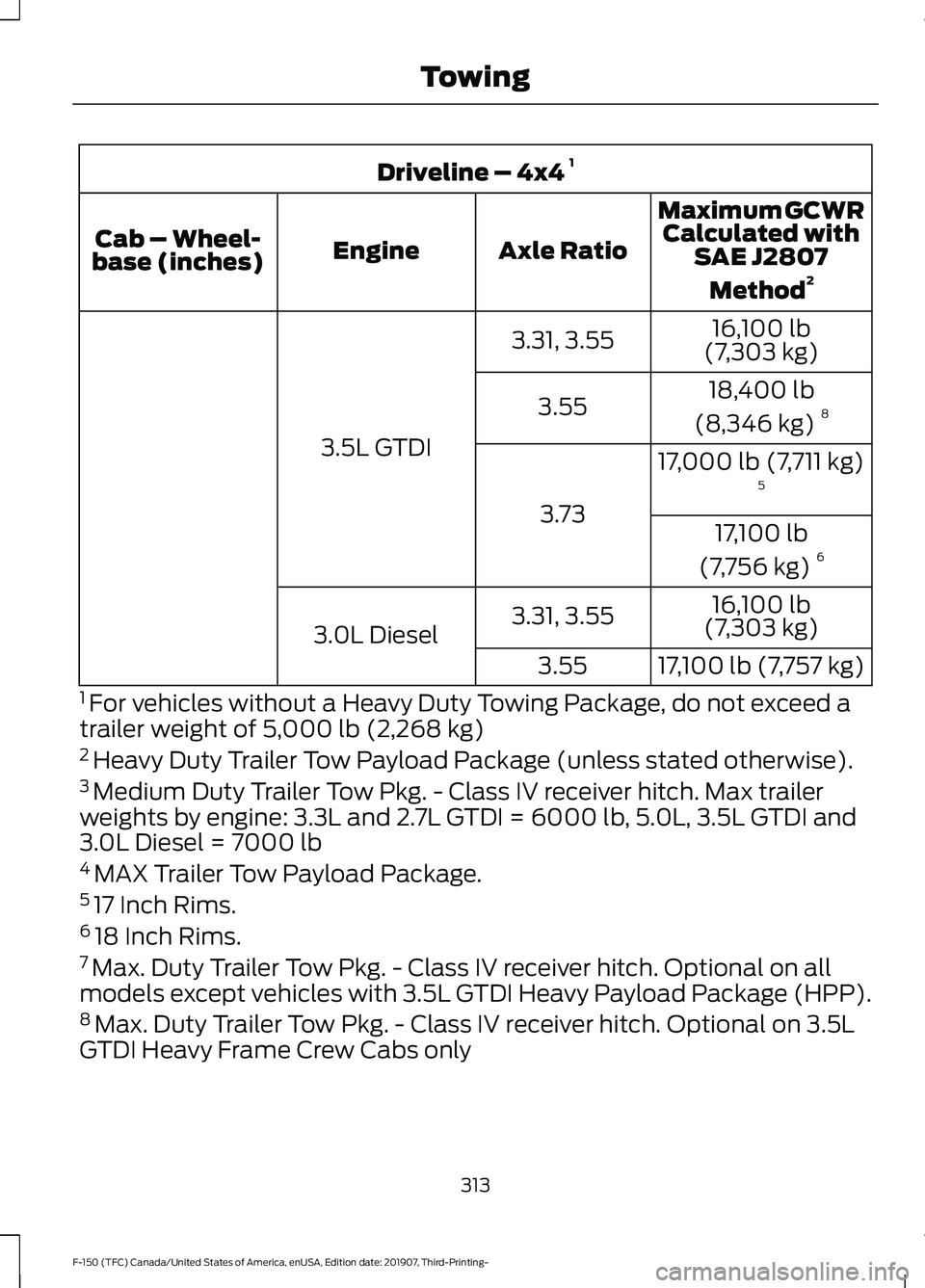
Driveline – 4x4
1
Maximum GCWRCalculated with SAE J2807
Method 2
Axle Ratio
Engine
Cab – Wheel-
base (inches)
16,100 lb
(7,303 kg)
3.31, 3.55
3.5L GTDI 18,400 lb
(8,346 kg) 8
3.55
17,000 lb (7,711 kg)5
3.73 17,100 lb
(7,756 kg) 6
16,100 lb
(7,303 kg)
3.31, 3.55
3.0L Diesel
17,100 lb (7,757 kg)
3.55
1 For vehicles without a Heavy Duty Towing Package, do not exceed a
trailer weight of 5,000 lb (2,268 kg)
2 Heavy Duty Trailer Tow Payload Package (unless stated otherwise).
3 Medium Duty Trailer Tow Pkg. - Class IV receiver hitch. Max trailer
weights by engine: 3.3L and 2.7L GTDI = 6000 lb, 5.0L, 3.5L GTDI and
3.0L Diesel = 7000 lb
4 MAX Trailer Tow Payload Package.
5 17 Inch Rims.
6 18 Inch Rims.
7 Max. Duty Trailer Tow Pkg. - Class IV receiver hitch. Optional on all
models except vehicles with 3.5L GTDI Heavy Payload Package (HPP).
8 Max. Duty Trailer Tow Pkg. - Class IV receiver hitch. Optional on 3.5L
GTDI Heavy Frame Crew Cabs only
313
F-150 (TFC) Canada/United States of America, enUSA, Edition date: 201907, Third-Printing- Towing
Page 317 of 625
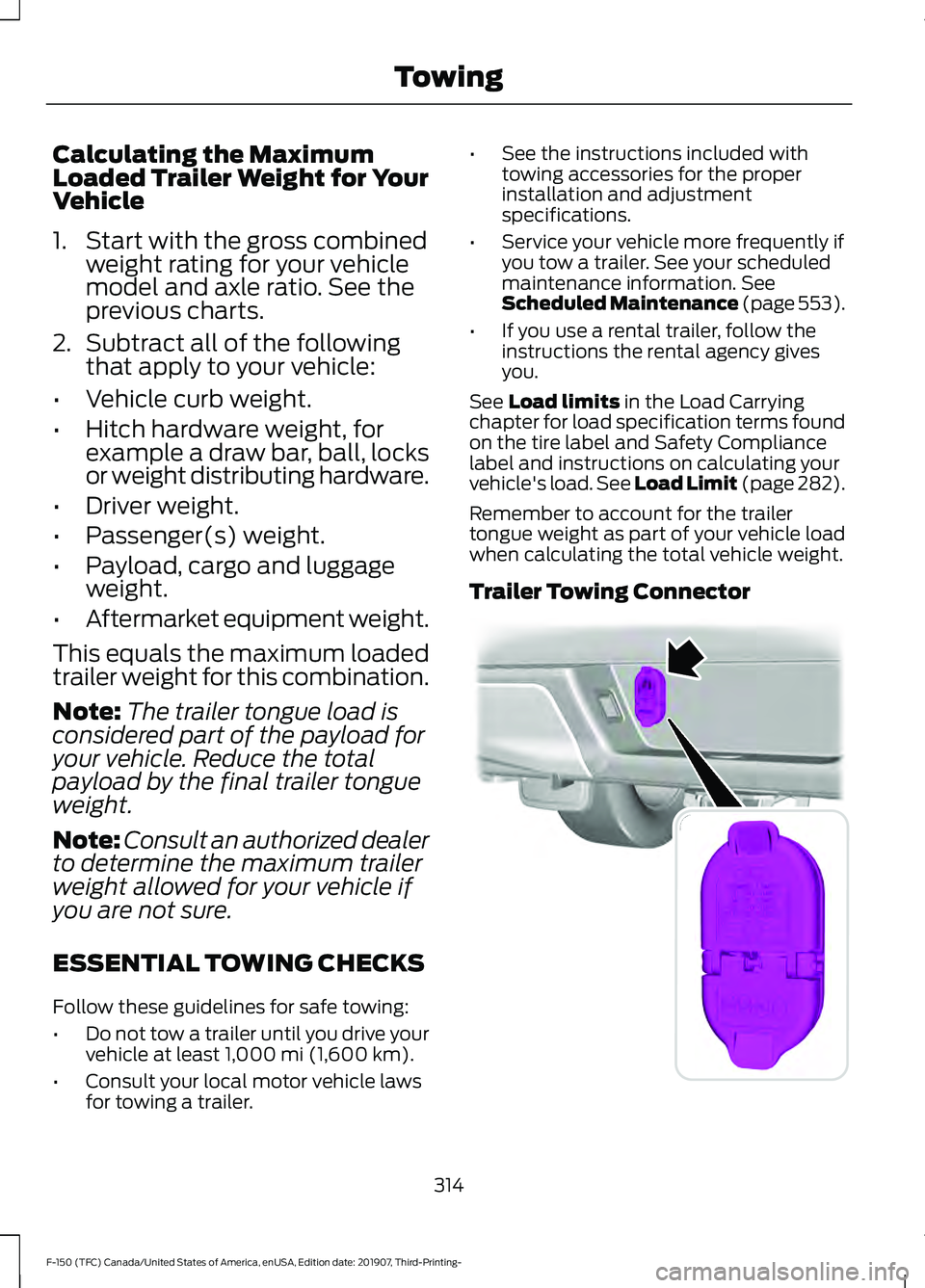
Calculating the Maximum
Loaded Trailer Weight for Your
Vehicle
1. Start with the gross combined
weight rating for your vehicle
model and axle ratio. See the
previous charts.
2. Subtract all of the following
that apply to your vehicle:
• Vehicle curb weight.
• Hitch hardware weight, for
example a draw bar, ball, locks
or weight distributing hardware.
• Driver weight.
• Passenger(s) weight.
• Payload, cargo and luggage
weight.
• Aftermarket equipment weight.
This equals the maximum loaded
trailer weight for this combination.
Note: The trailer tongue load is
considered part of the payload for
your vehicle. Reduce the total
payload by the final trailer tongue
weight.
Note: Consult an authorized dealer
to determine the maximum trailer
weight allowed for your vehicle if
you are not sure.
ESSENTIAL TOWING CHECKS
Follow these guidelines for safe towing:
• Do not tow a trailer until you drive your
vehicle at least 1,000 mi (1,600 km).
• Consult your local motor vehicle laws
for towing a trailer. •
See the instructions included with
towing accessories for the proper
installation and adjustment
specifications.
• Service your vehicle more frequently if
you tow a trailer. See your scheduled
maintenance information.
See
Scheduled Maintenance (page 553).
• If you use a rental trailer, follow the
instructions the rental agency gives
you.
See
Load limits in the Load Carrying
chapter for load specification terms found
on the tire label and Safety Compliance
label and instructions on calculating your
vehicle's load. See Load Limit (page 282).
Remember to account for the trailer
tongue weight as part of your vehicle load
when calculating the total vehicle weight.
Trailer Towing Connector 314
F-150 (TFC) Canada/United States of America, enUSA, Edition date: 201907, Third-Printing- TowingE193232
Page 318 of 625
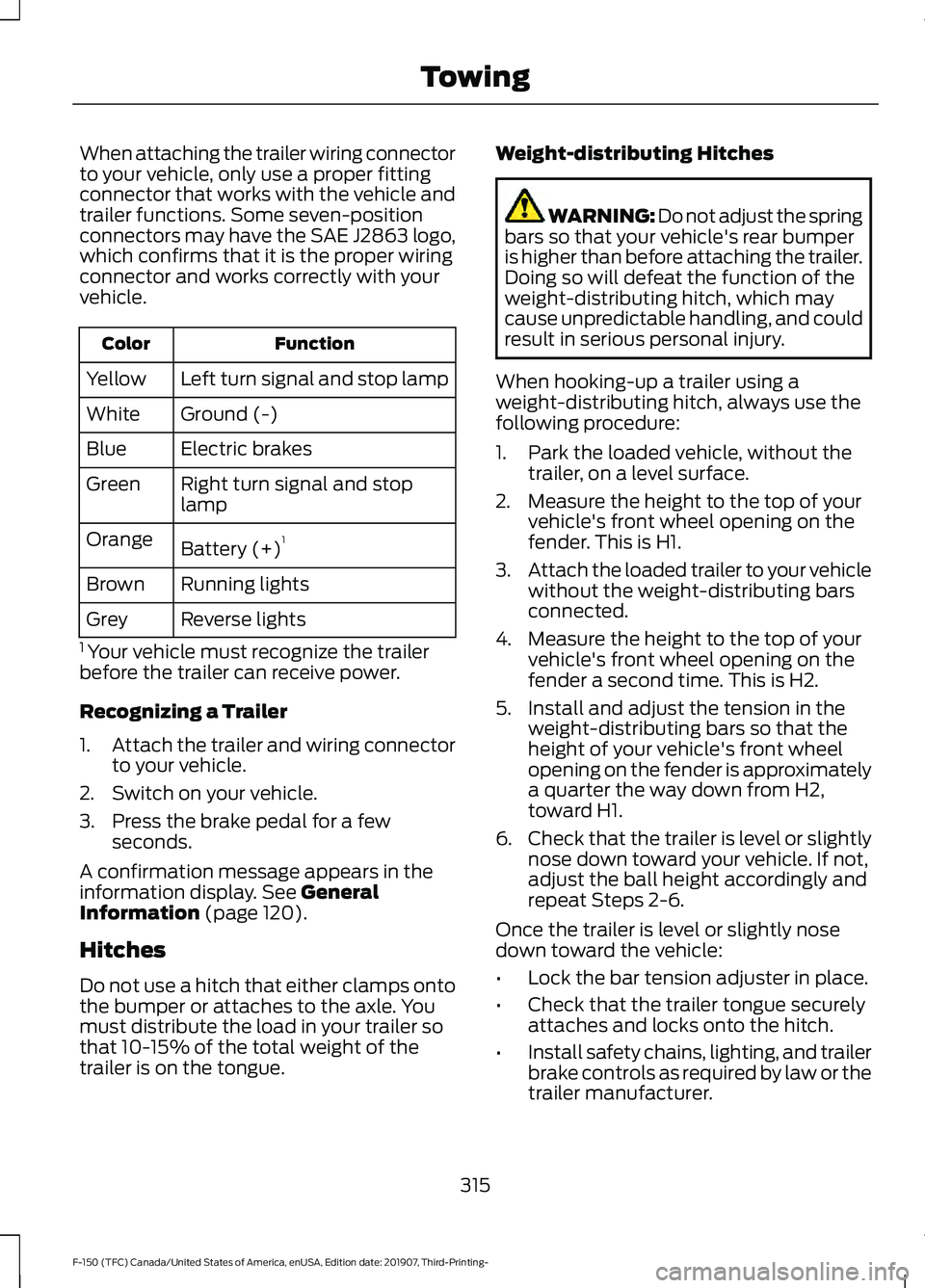
When attaching the trailer wiring connector
to your vehicle, only use a proper fitting
connector that works with the vehicle and
trailer functions. Some seven-position
connectors may have the SAE J2863 logo,
which confirms that it is the proper wiring
connector and works correctly with your
vehicle.
Function
Color
Left turn signal and stop lamp
Yellow
Ground (-)
White
Electric brakes
Blue
Right turn signal and stop
lamp
Green
Battery (+) 1
Orange
Running lights
Brown
Reverse lights
Grey
1 Your vehicle must recognize the trailer
before the trailer can receive power.
Recognizing a Trailer
1. Attach the trailer and wiring connector
to your vehicle.
2. Switch on your vehicle.
3. Press the brake pedal for a few seconds.
A confirmation message appears in the
information display. See General
Information (page 120).
Hitches
Do not use a hitch that either clamps onto
the bumper or attaches to the axle. You
must distribute the load in your trailer so
that 10-15% of the total weight of the
trailer is on the tongue. Weight-distributing Hitches WARNING: Do not adjust the spring
bars so that your vehicle's rear bumper
is higher than before attaching the trailer.
Doing so will defeat the function of the
weight-distributing hitch, which may
cause unpredictable handling, and could
result in serious personal injury.
When hooking-up a trailer using a
weight-distributing hitch, always use the
following procedure:
1. Park the loaded vehicle, without the trailer, on a level surface.
2. Measure the height to the top of your vehicle's front wheel opening on the
fender. This is H1.
3. Attach the loaded trailer to your vehicle
without the weight-distributing bars
connected.
4. Measure the height to the top of your vehicle's front wheel opening on the
fender a second time. This is H2.
5. Install and adjust the tension in the weight-distributing bars so that the
height of your vehicle's front wheel
opening on the fender is approximately
a quarter the way down from H2,
toward H1.
6. Check that the trailer is level or slightly
nose down toward your vehicle. If not,
adjust the ball height accordingly and
repeat Steps 2-6.
Once the trailer is level or slightly nose
down toward the vehicle:
• Lock the bar tension adjuster in place.
• Check that the trailer tongue securely
attaches and locks onto the hitch.
• Install safety chains, lighting, and trailer
brake controls as required by law or the
trailer manufacturer.
315
F-150 (TFC) Canada/United States of America, enUSA, Edition date: 201907, Third-Printing- Towing
Page 319 of 625
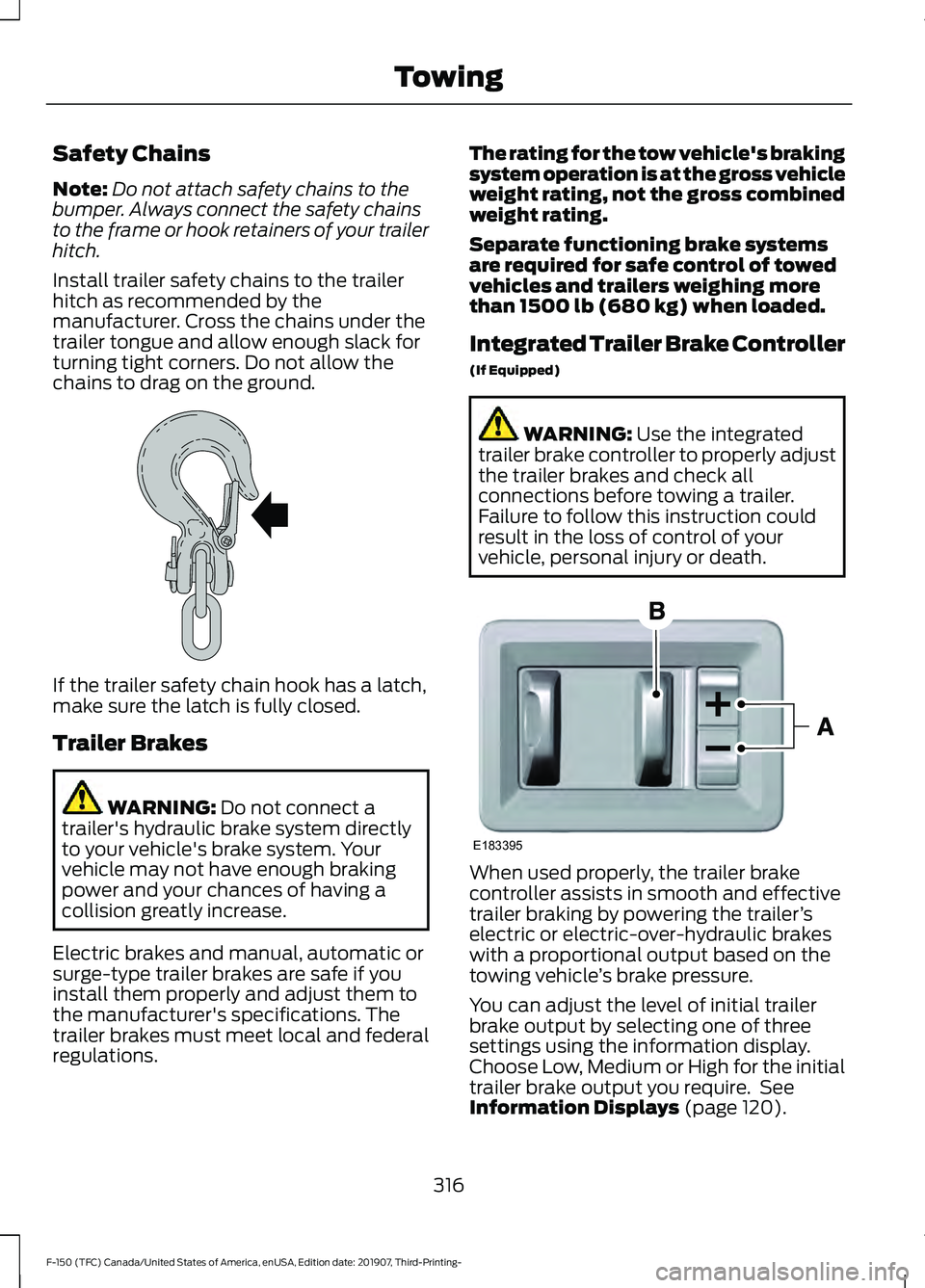
Safety Chains
Note:
Do not attach safety chains to the
bumper. Always connect the safety chains
to the frame or hook retainers of your trailer
hitch.
Install trailer safety chains to the trailer
hitch as recommended by the
manufacturer. Cross the chains under the
trailer tongue and allow enough slack for
turning tight corners. Do not allow the
chains to drag on the ground. If the trailer safety chain hook has a latch,
make sure the latch is fully closed.
Trailer Brakes
WARNING: Do not connect a
trailer's hydraulic brake system directly
to your vehicle's brake system. Your
vehicle may not have enough braking
power and your chances of having a
collision greatly increase.
Electric brakes and manual, automatic or
surge-type trailer brakes are safe if you
install them properly and adjust them to
the manufacturer's specifications. The
trailer brakes must meet local and federal
regulations. The rating for the tow vehicle's braking
system operation is at the gross vehicle
weight rating, not the gross combined
weight rating.
Separate functioning brake systems
are required for safe control of towed
vehicles and trailers weighing more
than 1500 lb (680 kg) when loaded.
Integrated Trailer Brake Controller
(If Equipped)
WARNING:
Use the integrated
trailer brake controller to properly adjust
the trailer brakes and check all
connections before towing a trailer.
Failure to follow this instruction could
result in the loss of control of your
vehicle, personal injury or death. When used properly, the trailer brake
controller assists in smooth and effective
trailer braking by powering the trailer
’s
electric or electric-over-hydraulic brakes
with a proportional output based on the
towing vehicle ’s brake pressure.
You can adjust the level of initial trailer
brake output by selecting one of three
settings using the information display.
Choose Low, Medium or High for the initial
trailer brake output you require. See
Information Displays
(page 120).
316
F-150 (TFC) Canada/United States of America, enUSA, Edition date: 201907, Third-Printing- TowingE265060 E183395
Page 320 of 625
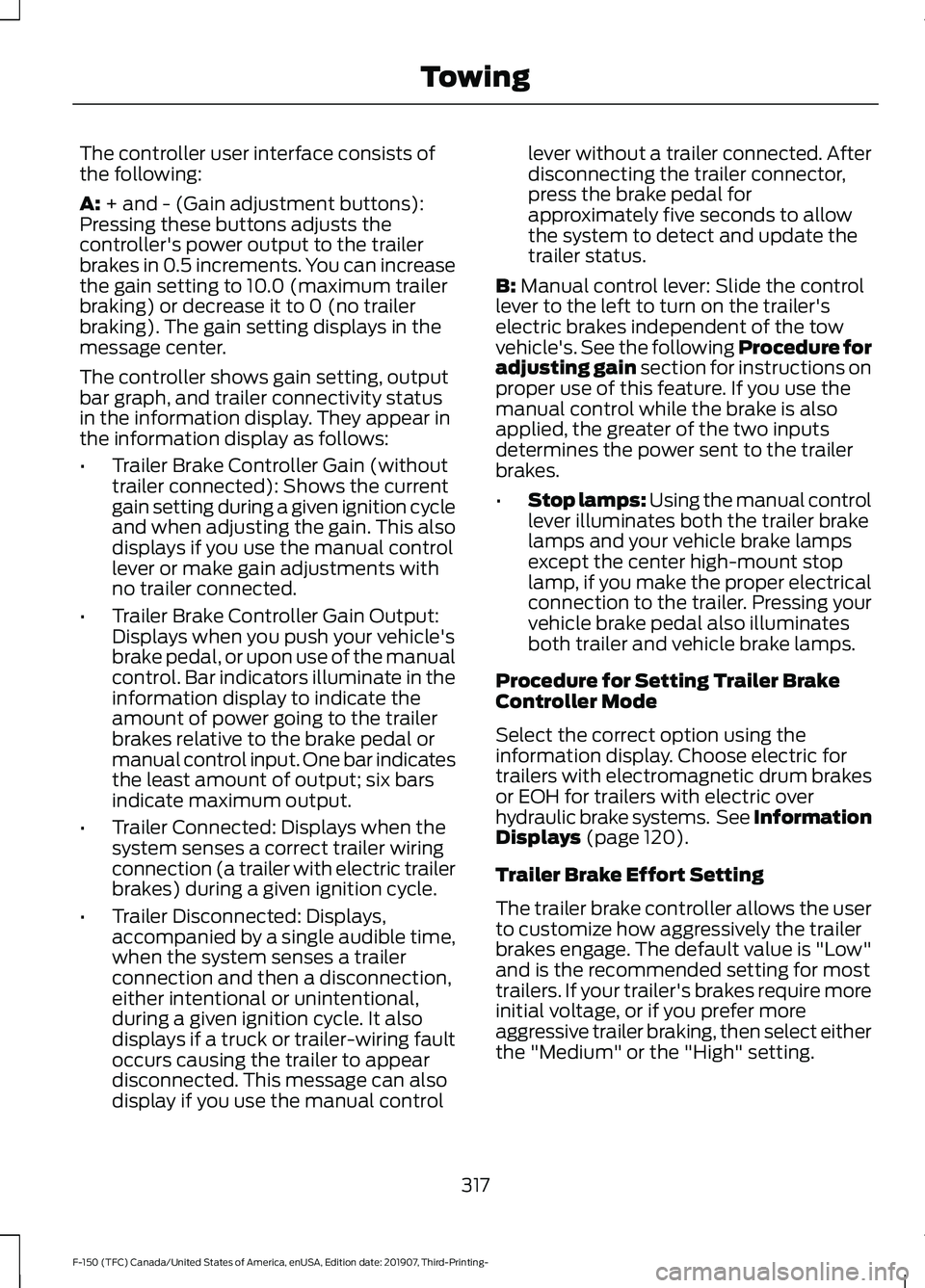
The controller user interface consists of
the following:
A: + and - (Gain adjustment buttons):
Pressing these buttons adjusts the
controller's power output to the trailer
brakes in 0.5 increments. You can increase
the gain setting to 10.0 (maximum trailer
braking) or decrease it to 0 (no trailer
braking). The gain setting displays in the
message center.
The controller shows gain setting, output
bar graph, and trailer connectivity status
in the information display. They appear in
the information display as follows:
• Trailer Brake Controller Gain (without
trailer connected): Shows the current
gain setting during a given ignition cycle
and when adjusting the gain. This also
displays if you use the manual control
lever or make gain adjustments with
no trailer connected.
• Trailer Brake Controller Gain Output:
Displays when you push your vehicle's
brake pedal, or upon use of the manual
control. Bar indicators illuminate in the
information display to indicate the
amount of power going to the trailer
brakes relative to the brake pedal or
manual control input. One bar indicates
the least amount of output; six bars
indicate maximum output.
• Trailer Connected: Displays when the
system senses a correct trailer wiring
connection (a trailer with electric trailer
brakes) during a given ignition cycle.
• Trailer Disconnected: Displays,
accompanied by a single audible time,
when the system senses a trailer
connection and then a disconnection,
either intentional or unintentional,
during a given ignition cycle. It also
displays if a truck or trailer-wiring fault
occurs causing the trailer to appear
disconnected. This message can also
display if you use the manual control lever without a trailer connected. After
disconnecting the trailer connector,
press the brake pedal for
approximately five seconds to allow
the system to detect and update the
trailer status.
B:
Manual control lever: Slide the control
lever to the left to turn on the trailer's
electric brakes independent of the tow
vehicle's. See the following Procedure for
adjusting gain section for instructions on
proper use of this feature. If you use the
manual control while the brake is also
applied, the greater of the two inputs
determines the power sent to the trailer
brakes.
• Stop lamps: Using the manual control
lever illuminates both the trailer brake
lamps and your vehicle brake lamps
except the center high-mount stop
lamp, if you make the proper electrical
connection to the trailer. Pressing your
vehicle brake pedal also illuminates
both trailer and vehicle brake lamps.
Procedure for Setting Trailer Brake
Controller Mode
Select the correct option using the
information display. Choose electric for
trailers with electromagnetic drum brakes
or EOH for trailers with electric over
hydraulic brake systems. See Information
Displays
(page 120).
Trailer Brake Effort Setting
The trailer brake controller allows the user
to customize how aggressively the trailer
brakes engage. The default value is "Low"
and is the recommended setting for most
trailers. If your trailer's brakes require more
initial voltage, or if you prefer more
aggressive trailer braking, then select either
the "Medium" or the "High" setting.
317
F-150 (TFC) Canada/United States of America, enUSA, Edition date: 201907, Third-Printing- Towing